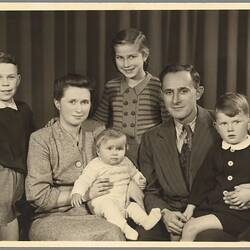Summary
Black and white photograph adhered to album page 13, of a view of landfall in the Suez Canal from the MS Skaubryn, taken by Walter Lischke during his migrant voyage in 1955.
The inscription, handwritten by Walter Lischke in German, reads: 'Wir haben in der Nacht den Kanal passiert und liegen vor Suez. Die Sonne geht über der Wüste und dem roten Meer auf.' (Translation: We passed through the canal overnight and are moored near Suez. The sun rises over the desert and the Red Sea').
This photograph is one of a series of forty black and white photographs adhered to pages within a small album. The photographs were taken by Walter Lischke, before, during and just after his migrant voyage to Australia with his wife and four children on the MS Skaubryn in November-December 1955. Walter put the photos in the album after arriving, entitled 'Our Australian Trip 20.11 - 31.12.1955...Our dear grandmother', and sent it back to his wife Gerda's mother in Germany. After she died three years later, the album came back to the family in Australia.
The album, with each photograph annotated in German, commences in Bremerhaven from where the family departed Germany, and follows their journey to Australia. Also refer to record HT53880, the camera with which Walter Lischke took all the photographs.
Description of Content
Ocean with land on horizon and ships railings in foreground.
Physical Description
Black and white photograph
Significance
Statement of Historical Significance:
This collection provides an evocative insight into one family's post World War II migrant journey, from processing and transport from Bremerhaven, Germany through the ship voyage, ports, arrival and processing at Station Pier, Bonegilla and their early settlement. The photo album compliments other diaries and photo journals in the Museum's collection and demonstrates the importance to migrants of documenting their journey and creating an enduring record of this seminal human experience. The camera with which the photographs were taken is also part of the collection, providing an often rare tangible link between the technology and what it produced and the technological era represented.
More Information
-
Collecting Areas
Migration & Cultural Diversity, Transport, Images & Image Making
-
Acquisition Information
Donation from Sybille Ims, 15 Apr 2015
-
Photographer
-
Ship Named
-
Format
Photograph, Black & White
-
Inscriptions
Caption handwritten in German: 'Wir haben in der Nacht den Kanal passiert und liegen vor Suez. Die Sonne geht über der Wüste und dem roten Meer auf'
-
Classification
-
Category
-
Discipline
-
Type of item
-
Keywords
German Immigration, Migrant Hostels, Migrant Reception Centres, Migrant Workers, Shipboard Travel, Photography, Displaced Persons, Refugees

